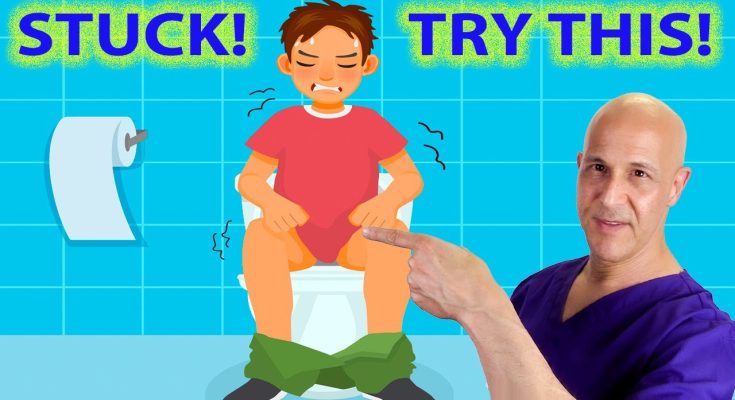We’re going to tackle a topic that nobody likes to talk about we’re going to dive into a subject that affects all of us using the bathroom so grab a seat on your own Royal Throne because we’re going to uncover the surprising science behind your bathroom habits and how to make those trips a breeze first up let’s talk about how we sit on the toilet did you know that the angle in which you sit can have a huge impact on your colon when you’re sitting with your knees lower than your hips it creates a kink
in your colon imagine trying to slide down a slide with a big old bump in the middle that’s why elevating those knees can totally change the game so when you lean forward or elevate your feet it straightens that kink out allowing for smoother progress and a more pleasant experience now here’s the fun part when you raise those knees above hip level it relaxes the pubo rectus muscle this muscle forms a sling around the rectum and can create a tight angle when we’re sitting by elevating the knees you
straighten the anal rectal angle making it easier for things to slide on through think of it as giving your cone a little highway to drive on and if you really want to take it up a notch let’s talk about movement a gentle lean back and forth can further alter the angle of your body this shimming encourages the peristaltic movement of your intestines the wavelike muscle contractions that push the stool through your colon you can say it’s like guiding a stubborn train onto its tracks just a little shift can really smooth out the process
you might even feel your body say thanks for the help now let’s dive into some fascinating physiology the human body pretty much Evolved first squatting in fact in many cultures where squat toilets are the norm there are significantly lower instances of constipation hemorrhoids and related issues why because squatting aligns the rectum and anus allowing for easier passage our anatomical design with the sigmoid colon gently curving before it reaches the rectum is optimized for a squatting position so when you elevate
those knees it replicates that natural posture allowing your body to do what it’s made to do okay so don’t underestimate the power of relaxation stress can create tension in your body including your pelvic floor muscles so take a deep breath and let it all go literally this isn’t just about musical chairs for your colon It’s about creating a supportive environment for ease and relaxation remember it’s not a race it’s a leisurely stroll through your digestive system so what’s the takeaway here my bathroom buddies
elevating those knees helps straighten the colon and a little lean can give everything that nudge it needs to roll out so let’s be honest who knew that achieving bathroom Bliss could involve so much science just remember it’s not a race and if it takes a little longer you can always use that time to plan for your next Great Escape so until next time may your throne always be your happy place and may your business be as smooth as the jokes you tell your friends so I hope you enjoyed this video and I hope you learn something from it
as well please share this with your friends and family leave your comments below and most important make it a great day I’m Dr Alan Mandell.
Here are the key points:
- Sitting position matters : Sitting with knees lower than hips creates a kink in the colon, making it harder to pass stool. Elevating your knees or leaning forward helps straighten the colon, allowing for smoother bowel movements.
- Relaxing muscles : Raising knees above hip level relaxes the puborectalis muscle, straightening the anorectal angle, which facilitates easier passage of stool.
- Movement helps: Gentle back-and-forth movement while seated encourages peristaltic muscle contractions in the intestines, aiding in the movement of stool through the colon.
- Squatting position: The body evolved to squat, which aligns the rectum and anus for easier passage. Elevating the knees replicates this natural posture, reducing constipation and related issues.
- Relaxation is key: Stress and tension in pelvic floor muscles can hinder bowel movements. Taking deep breaths and relaxing while on the toilet can support a smoother process.
Watch the video here….
Did you know that the way you sit on the toilet can significantly impact your bathroom experience? In this video, we explore the importance of elevating your knees above your hips while seated. By adjusting your posture, you can relax the puborectalis muscle, which helps straighten the anorectal angle for a smoother and easier elimination process.
This simple adjustment mimics the natural squatting position that our bodies are designed for, encouraging more effective bowel movements and reducing the risk of constipation and straining. Join us as we break down the science behind this effective bathroom habit, and learn tips to make your time on the throne as comfortable and efficient as possible!



